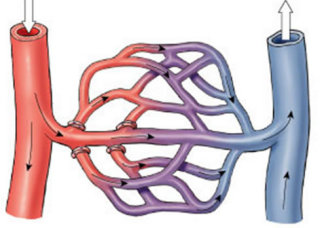Capillaries are thin-walled blood vessels in which gas exchange occurs. In the capillary, the wall is only one cell layer thick. Capillaries are concentrated into capillary beds. Some capillaries have small pores between the cells of the capillary wall, allowing materials to flow in and out of capillaries as well as the passage of white blood cells. Nutrients, wastes, and hormones are exchanged across the thin walls of capillaries. Capillaries are microscopic in size, although blushing is one manifestation of blood flow into capillaries. Control of blood flow into capillary beds is done by nerve-controlled sphincters.

The circulatory system functions in the delivery of oxygen, nutrient molecules, and hormones and the removal of carbon dioxide, ammonia and other metabolic wastes. Capillaries are the points of exchange between the blood and surrounding tissues. Materials cross in and out of the capillaries by passing through or between the cells that line the capillary.
The extensive network of capillaries in the human body is estimated at between 50,000 and 60,000 miles long. Thoroughfare channels allow blood to bypass a capillary bed. These channels can open and close by the action of muscles that control blood flow through the channels.



